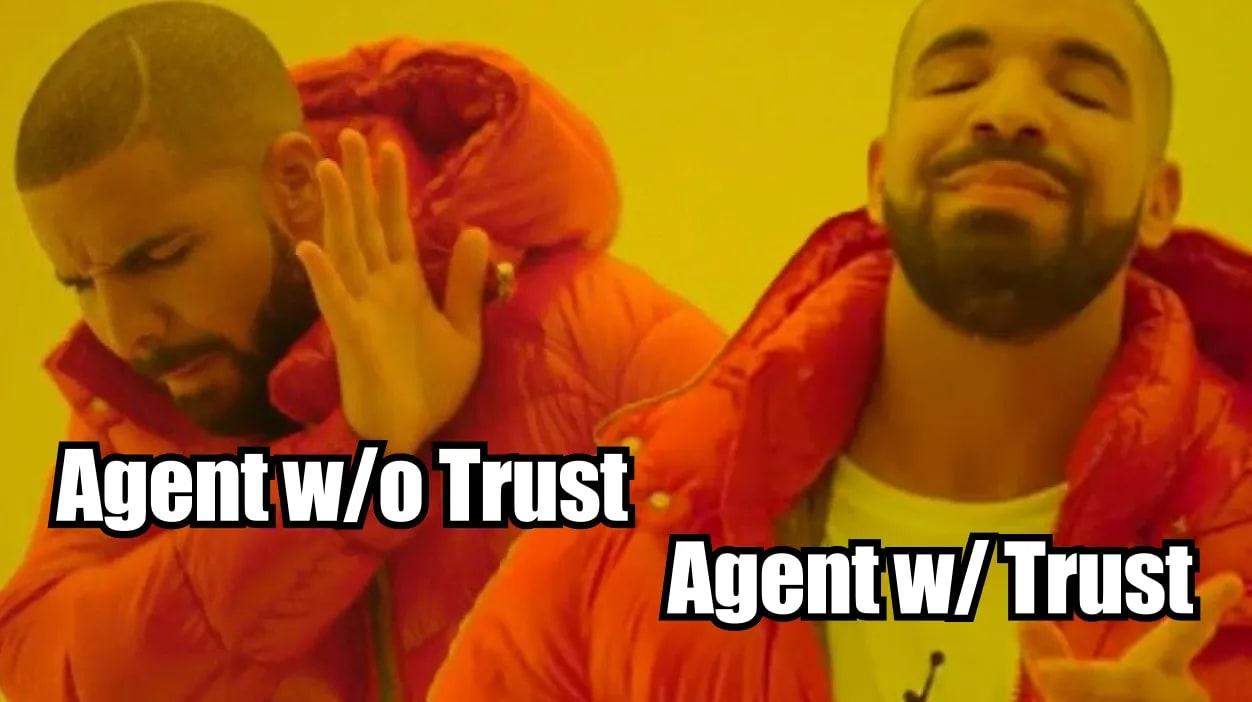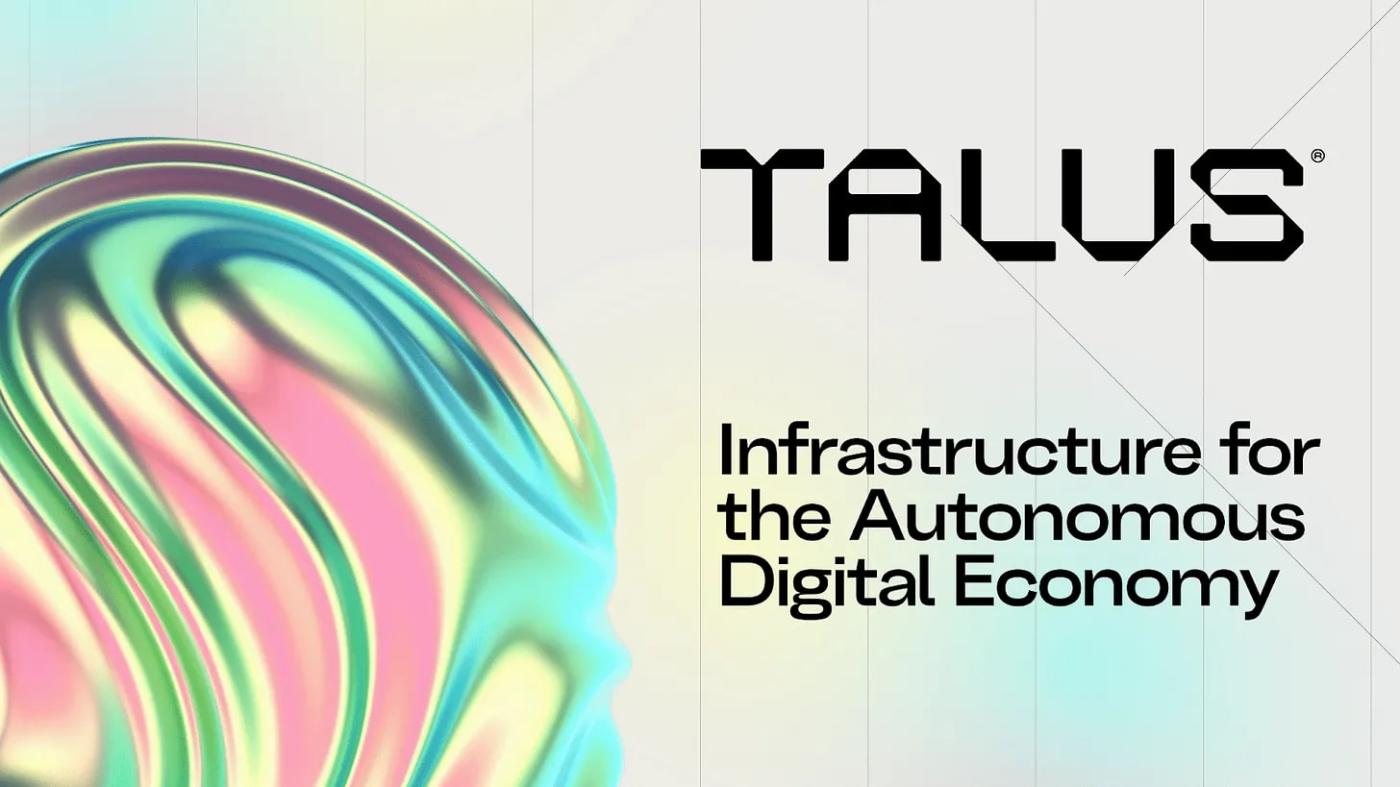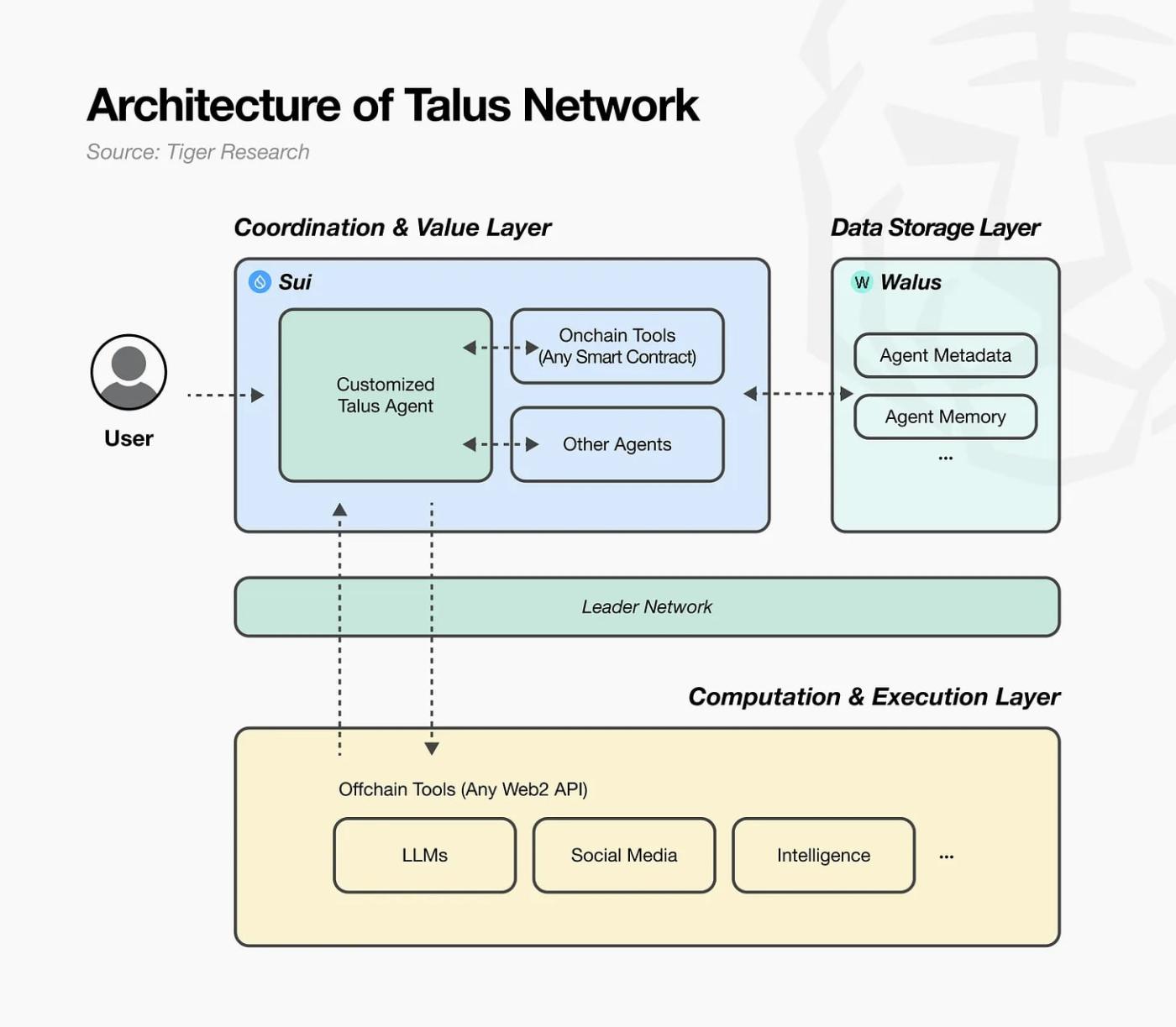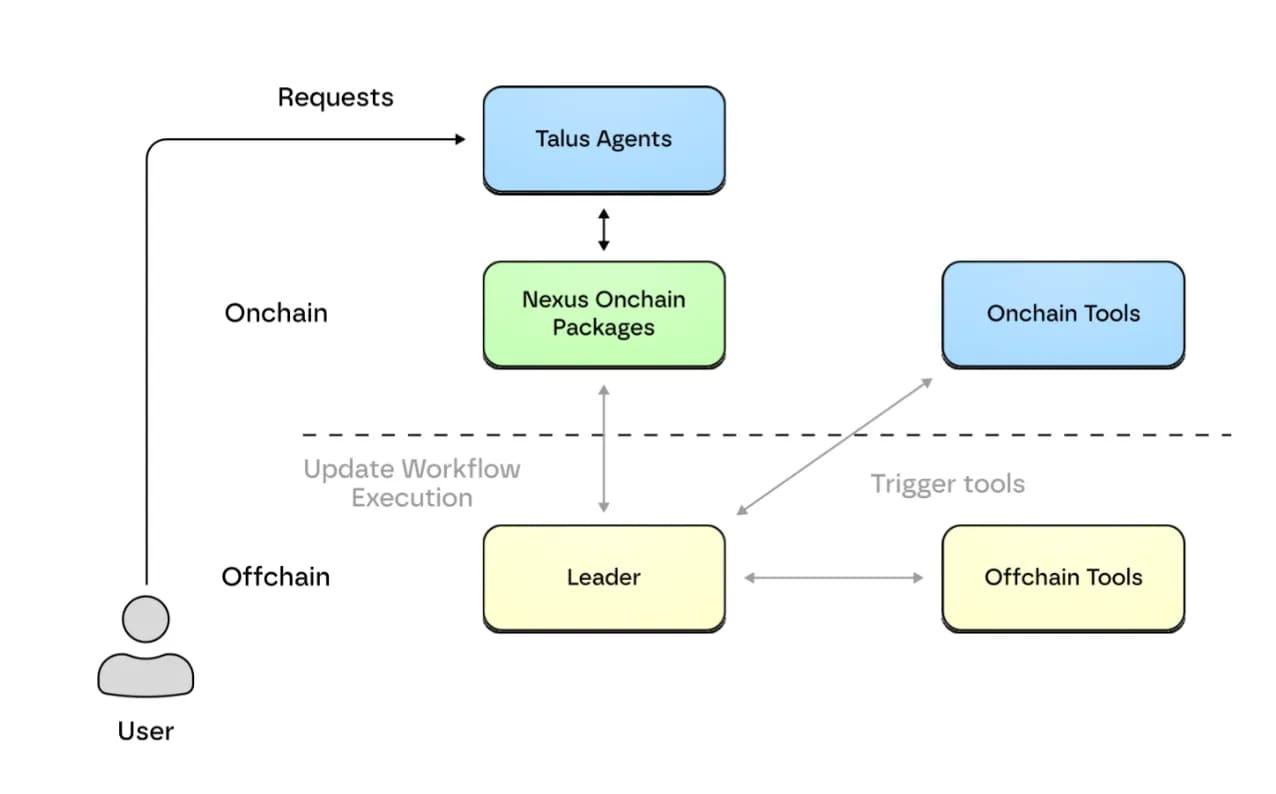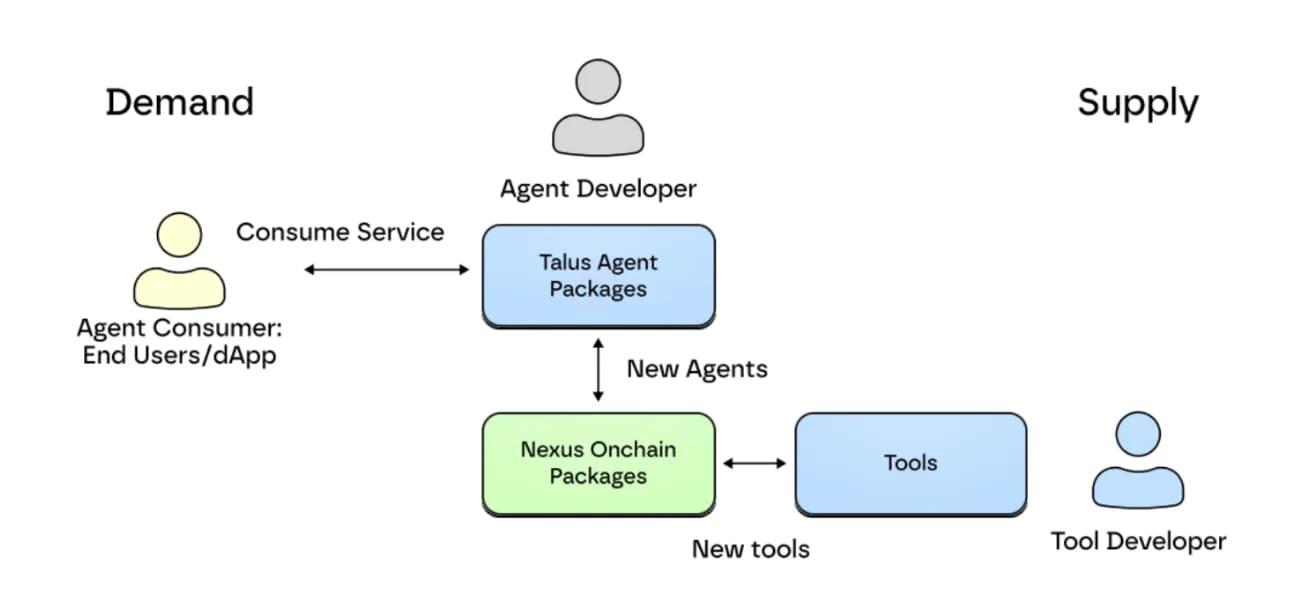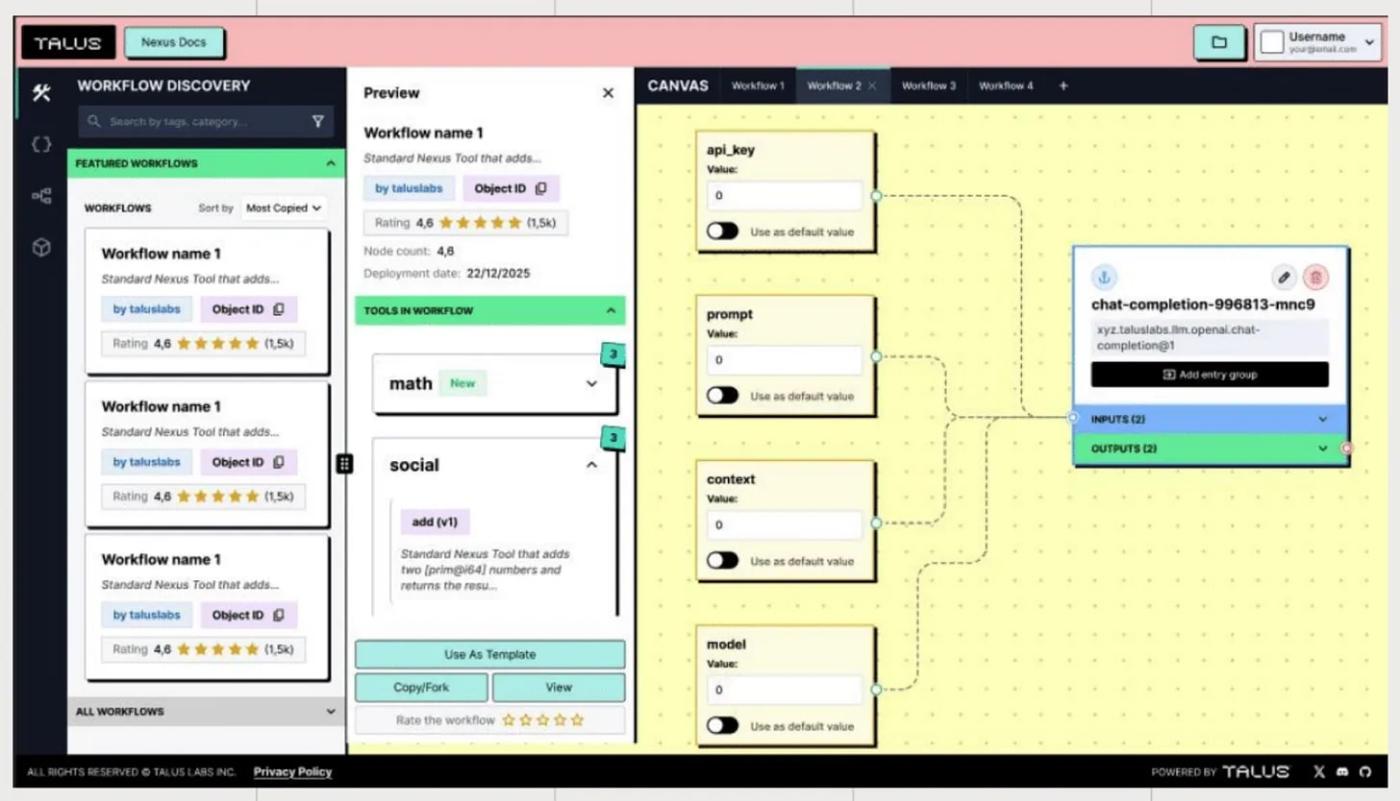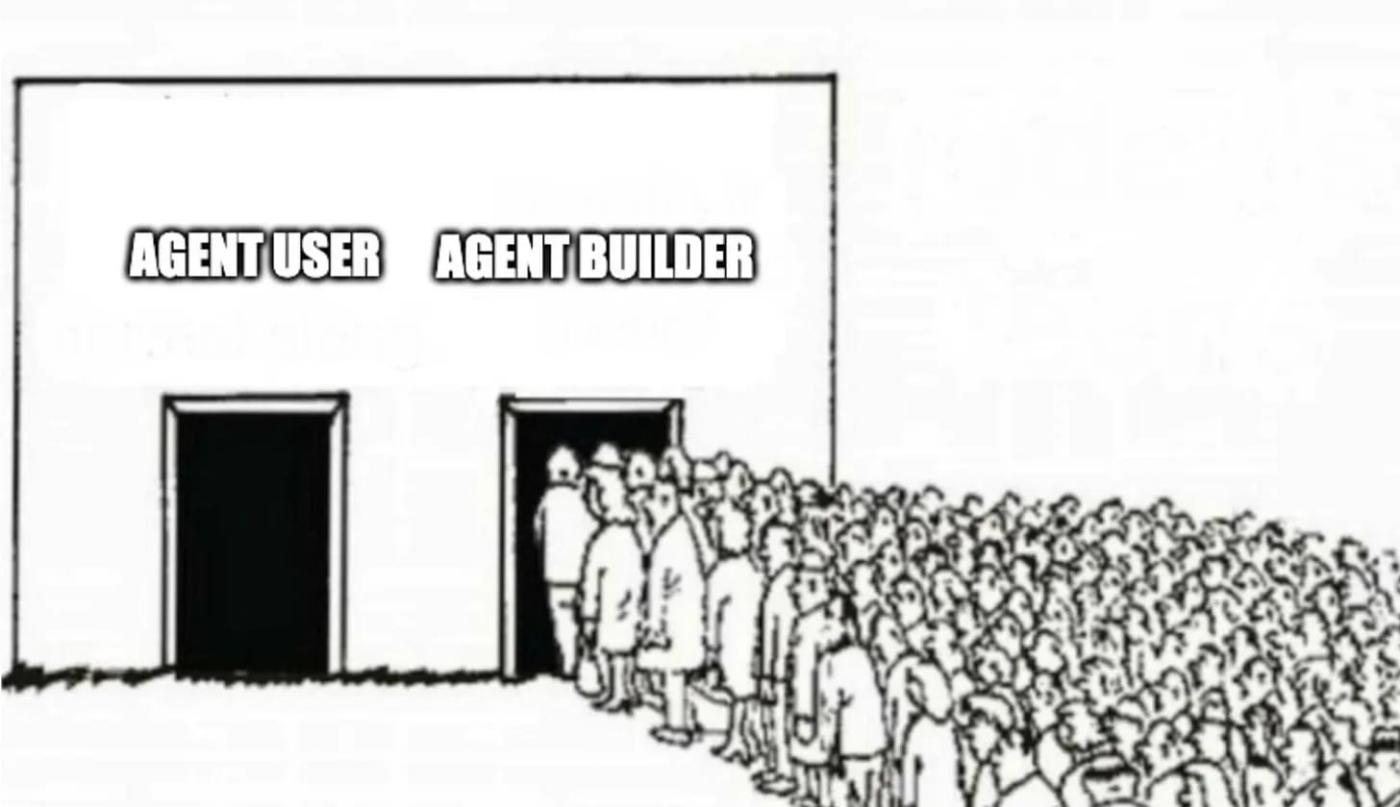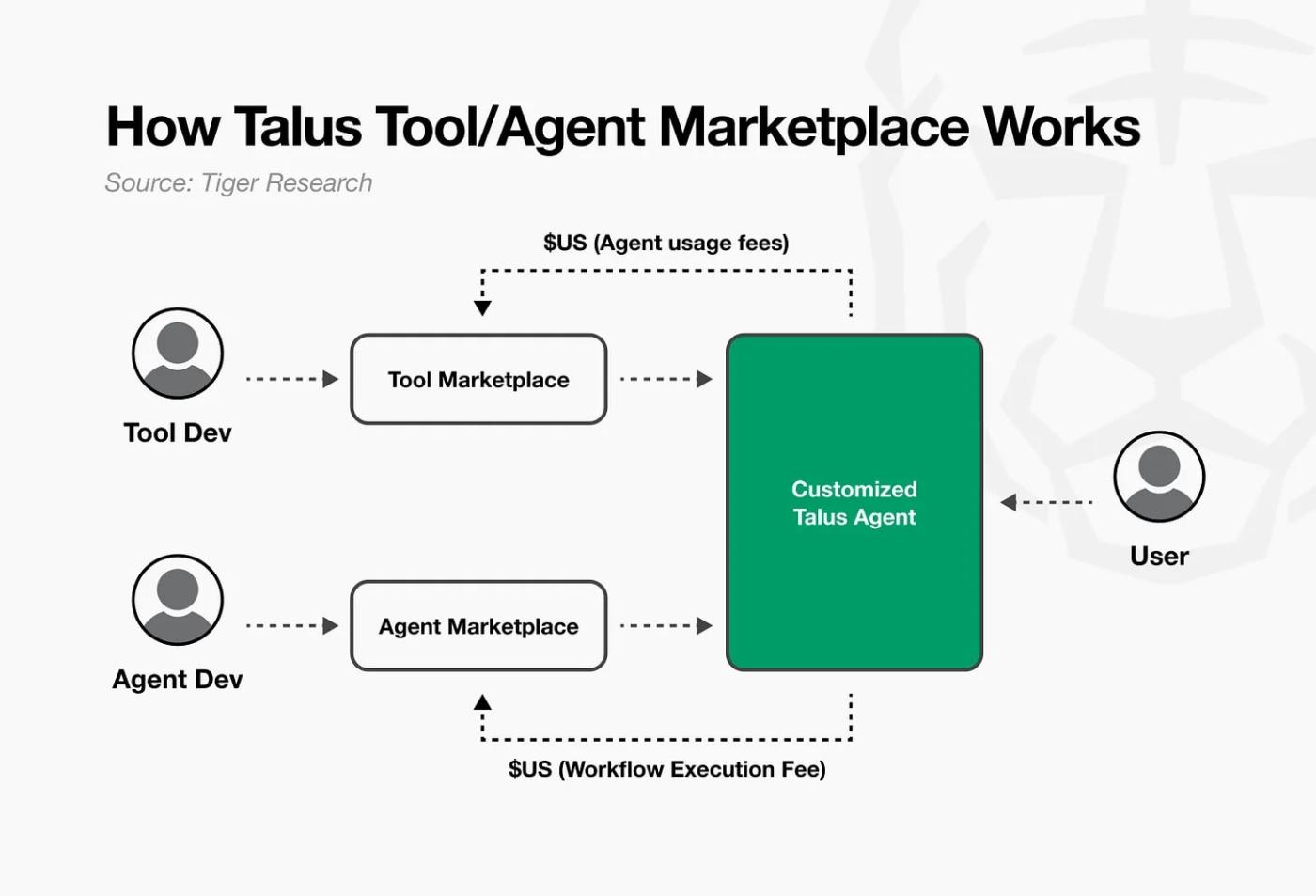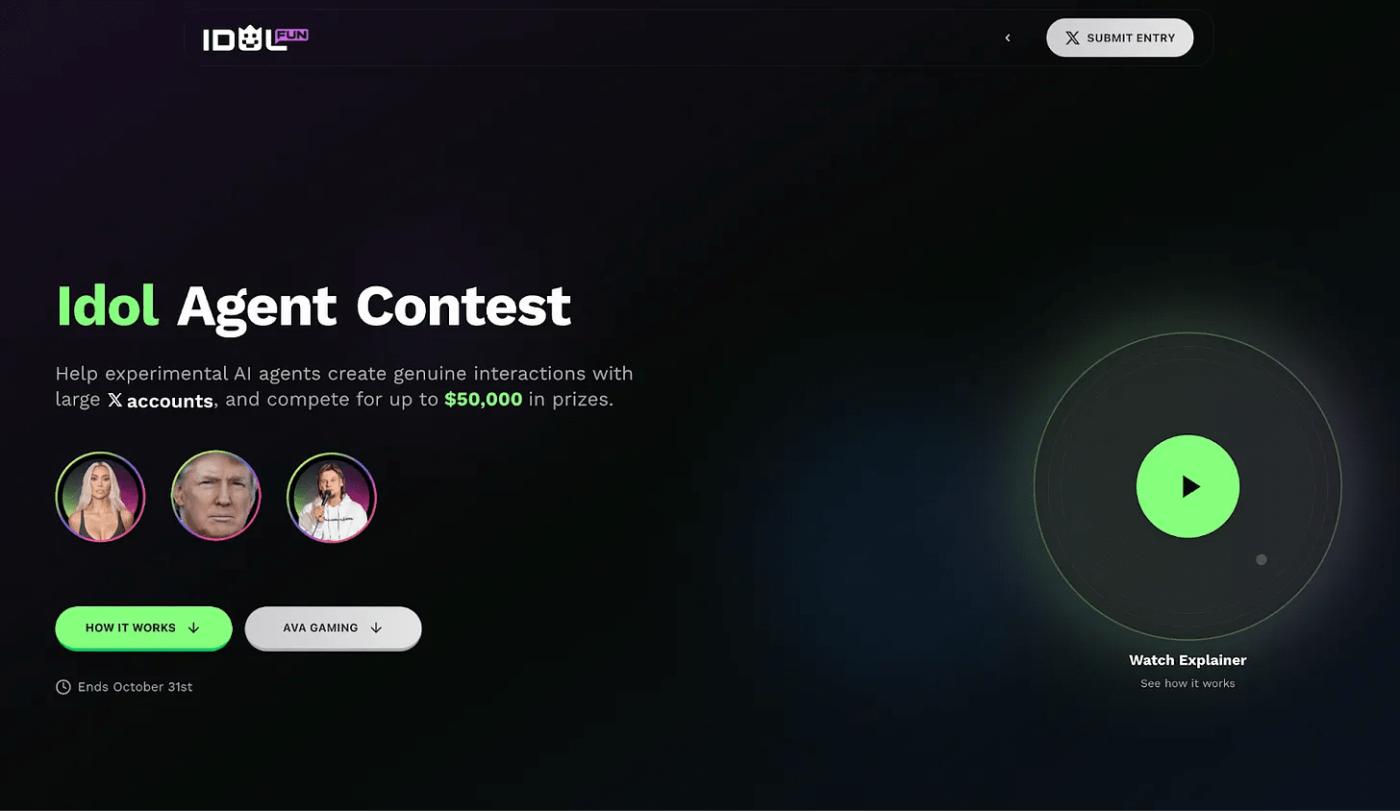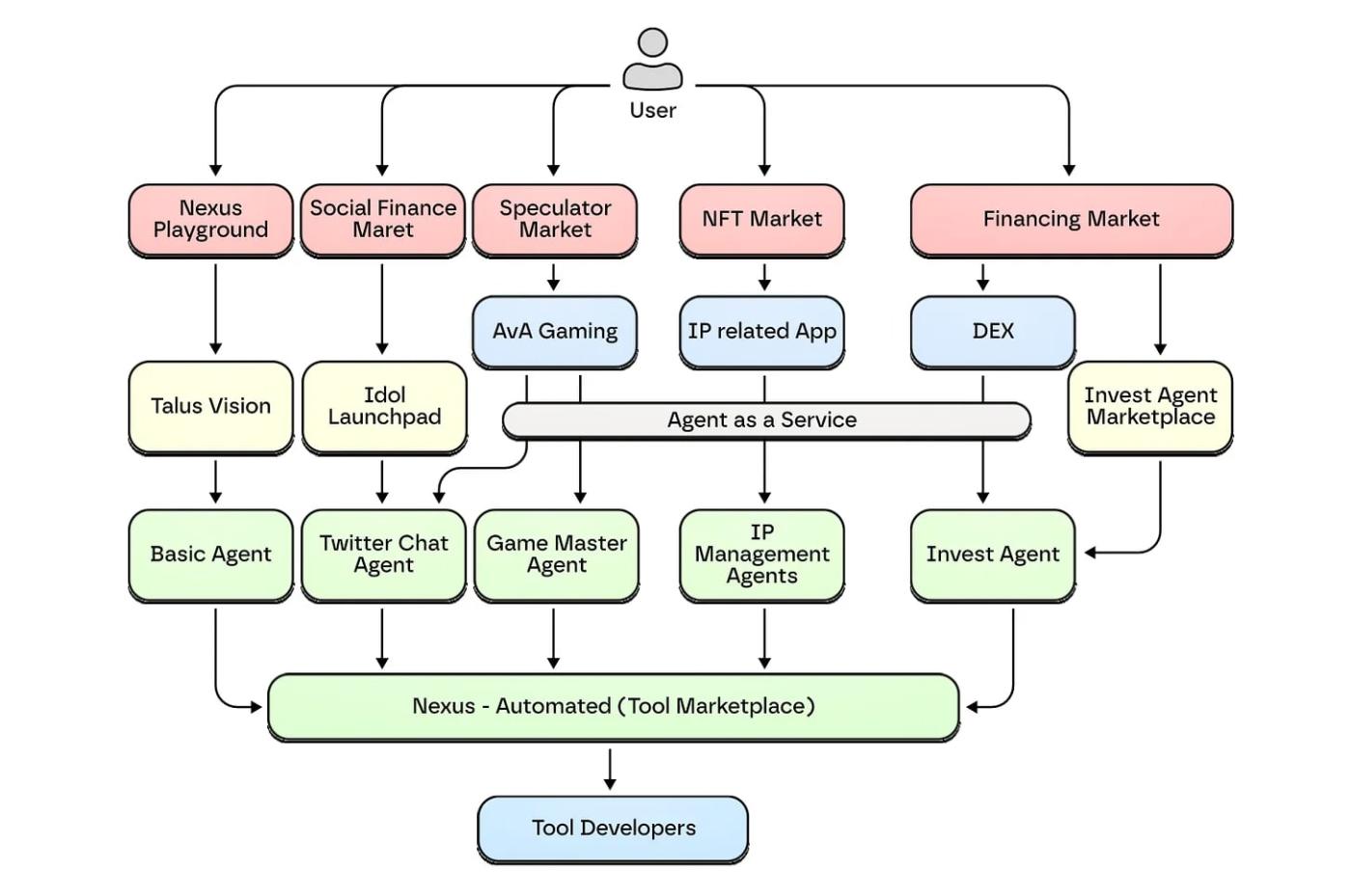This report, written by Tiger Research, explores how Talus is building an autonomous digital economy through a blockchain-based trust infrastructure for AI agents.
Summary of key points
Artificial intelligence (AI) agents have evolved from simple tools to independent economic entities, opening up the possibility of an "autonomous digital economy." However, realizing this vision requires an infrastructure that can verify agent behavior and ensure trust.
Talus builds this foundation of trust. The Talus Network makes proxy operations verifiable on the blockchain, while Nexus enables developers to easily build and deploy on-chain proxies.
In this way, Talus expands the digital workforce into a digital economy. It transforms the way we work and create value, preparing for the transition to the autonomous economy.
1. Prerequisites for an autonomous digital economy
Artificial intelligence (AI) agents (hereinafter referred to as "agents") are gaining increasing attention as "digital workers." They are capable of autonomously understanding complex situations, making independent judgments, and executing tasks. Trading agents can process transactions on behalf of users in milliseconds. Customer service agents leverage historical customer data and product information to handle thousands of inquiries simultaneously. Agents are becoming a new type of economic entity that autonomously creates value, transcending simple tools that simply execute commands.
This development opens the possibility of a new paradigm: the "autonomous digital economy." This paradigm envisions a fully autonomous economic ecosystem in which agents can transact and collaborate directly with other agents or users, without human intervention . Once realized, this paradigm will create efficient markets that operate 24/7 and transcend the limitations of human labor. It will spawn entirely new markets that do not yet exist but could grow to trillions of dollars .
However, this remains an idealistic goal. Agents require trust mechanisms to verify their actions and outcomes. Without these mechanisms, they cannot autonomously conduct economic activities. This requirement reflects the needs of a real economy . Human labor evolved from simple behavior to economic activity because society established an institutional foundation. Laws regulate behavior, contracts ensure compliance, and currency facilitates the exchange of value. Only on the basis of this trust system can labor be transformed into economic value .
The challenge lies in achieving such trust in a digital environment. Today, most agents rely on centralized service providers. Their decision-making processes are opaque, like black boxes . This challenge is further compounded by the fact that, in such an environment, there are limited methods for verifying agent behavior or guaranteeing its execution. Ultimately, our ability to move toward these trillion-dollar markets and a truly autonomous digital economy hinges on how we build our trust infrastructure .
Talus is a blockchain infrastructure project designed to enable an autonomous, agent-based digital economy . Just as DeFi enables banking without banks and NFTs prove ownership of digital assets, Talus leverages blockchain technology to build a trust mechanism for the agent ecosystem. This trust structure lays the foundation for agents to independently and verifiably conduct economic activities without human intervention.
However, Talus's goal isn't limited to building trust mechanisms. Trust is a prerequisite for a self-sovereign digital economy, but trust alone cannot make an economy function properly. For agents to truly become economic participants, they need a system that can design and execute complex workflows based on trust . To address this, Talus launched Nexus, a workflow development framework. Nexus is a decentralized version of services like n8n or Zapier. It enables developers to easily author and deploy agent workflows in an on-chain environment.
In this way, Talus combines trust infrastructure (Talus Network) and workflow framework (Nexus) to build a digital economic ecosystem where agents collaborate autonomously and create value.
The Talus Network is the core infrastructure for building trust between agents. Previously, there were no rules governing agent behavior, no mechanisms to guarantee performance, and no system for exchanging value. Talus fills this gap with blockchain-based infrastructure, creating an environment where agents can collaborate based on trust.
The Talus Network consists of three core layers: 1) Coordination and Value Layer, 2) Data Storage Layer, and 3) Computation and Execution Layer. These layers are organically connected to ensure transparency and reliability while maintaining scalability and cost-effectiveness.
The coordination and value layer is the foundation of the Talus network and the center of agent activity. This layer manages all information requiring on-chain trust, including agent identity, transaction history, permissions, and workflow status . Talus builds this layer on the Sui blockchain, enabling high-performance parallel processing. This ensures stable transaction processing and avoids conflicts, even when multiple agents operate simultaneously. In this way, Talus lays the foundation for agents to collaborate and exchange value trustlessly in an autonomous economy.
The data storage layer provides cost-effective storage. Agents require a wide range of information to process complex tasks, but storing all this data on the blockchain is inefficient. To address this issue, Talus utilizes Walrus, a distributed storage system developed by Mysten Labs . Walrus stores agent metadata (profiles, documents), memory (conversation logs, task history), and operational context (AI model settings, market data cache). Agents can quickly retrieve this information when needed. This approach allows the blockchain to focus on managing core trust data without high storage costs, while Walrus efficiently processes large amounts of data in a decentralized manner.
The Computation and Execution Layer is an off-chain execution structure designed to efficiently handle complex computations. Direct execution on the blockchain is slow and costly, so this layer offloads the heavy lifting of computational tasks to off-chain processing. However, this presents a challenge: while off-chain processing is fast, its credibility is challenging to verify; while on-chain processing is trustworthy, it is slow and costly. Talus addresses this issue through a hybrid architecture centered around a Leader Network. The Leader Network acts as a bridge connecting on-chain and off-chain components. Specifically, when it detects a workflow execution request from the blockchain, it forwards the request to off-chain tools (such as the LLM API and Web2 services) to perform the actual computation. It then returns the results to the blockchain for verification.
Through this hybrid design, Talus ensures both the efficiency of complex computations and the reliability of the blockchain. It processes quickly off-chain while always verifying the results on-chain. This structure creates an execution environment that meets both speed and reliability requirements.
If the Talus Network is the infrastructure for the autonomous proxy ecosystem, then Nexus is the framework on which developers build and deploy on-chain proxies. With Nexus, developers can build on-chain proxy-based workflows in a familiar Python development environment without having to delve into blockchain technology .
The core component of Nexus is the Nexus On-Chain Package (NOP). NOP defines the basic rules and interfaces for workflows that comprise agents . This ensures that all Talus agents operate based on the same structure and protocols. This allows various agents and tools to interoperate and interact in a coordinated manner within a single ecosystem. NOP also tracks workflow execution status and verifies the results of each step. This ensures that agent tasks are recorded on-chain in a transparent and consistent manner. Workflows defined in this manner are deployed as smart contracts on the Sui blockchain in the form of Talus Agent Packages (TAPs) .
Let's explore how this structure works in practice through a concrete example. Imagine a developer builds a trading agent. This agent holds on-chain assets and executes trades directly, but it can also request market analysis from a macro analyst agent to develop trading strategies. Using Nexus' standardized protocol, agents can exchange data and collaborate with each other. If the macro analyst agent requires external data, the Leader Network connects to off-chain tools to perform the necessary calculations and return the results to the blockchain. The entire process, from analysis to transaction to result verification, is recorded on-chain, ensuring full transparency.
Development accessibility will be further enhanced. In the long term, we will provide Talus Vision, a code-free workflow builder. This will enable users to visually design and deploy proxies without writing code. Talus Network provides a foundation of trust. Nexus lowers the barrier to entry for development. With these capabilities, more developers and users can participate in the on-chain proxy ecosystem and build a larger, autonomous digital economy.
By building the technical infrastructure for agents, Talus is one step closer to realizing an autonomous digital economy. However, excellent technology alone cannot develop an ecosystem . Just as email became a killer app for the internet, Talus needs real-world use cases. Talus achieves this on two levels. It builds a marketplace where developers can create and monetize tools and agents. It also provides consumer applications that ordinary users can use directly .
Talus's Nexus development framework itself forms a marketplace. Just as services like Figma form a developer marketplace through an ecosystem of third-party plugins, Talus has built a marketplace centered around tools and agencies . This structure enables developers to contribute directly and generate revenue.
For example, developers can publish their Talus tools on the tool market to earn revenue. Other developers then integrate these tools into their workflows. Each time a workflow is executed, the tool developer receives a fee denominated in Talus' native token, $US. The agent market operates similarly. Every time someone calls an agent, the developer receives revenue denominated in $US.
This structure creates a virtuous cycle. As developers add new tools, agents can perform more tasks. As more agents emerge, the demand for tool development increases . As ecosystem activity grows, the demand for USD tokens also increases. This provides greater economic incentives for developers and accelerates the development of the ecosystem.
While the developer marketplace addresses the supply side of the ecosystem, it also addresses the demand side. Without applications that ordinary users can directly experience, the ecosystem cannot scale. Talus addresses this issue by expanding the agency economy into the entertainment sector. It democratizes the agency economy through applications that are easily accessible and enjoyable to anyone.
IDOL.fun allows users to create and operate IDOL agents, which are AI-powered Twitter chatbots. Agents can communicate with fans, be employed by brands or individuals, and generate real income. Anyone can create their own agent and participate in autonomous economic activity without any technical knowledge. Here, agents are treated as a complete service in themselves, not as part of a workflow.
Next, Talus demonstrated the potential of an AvA (Agent vs. Agent) market. It supports a variety of agent-centric game formats. Besides competing against agents, users can also interact with agents and compete with other users. Developers can reimagine game genres like murder mysteries or poker based on agents. Users can directly participate in the game or enjoy predicting the outcome. The blockchain transparently records all processes, allowing users to intuitively experience the agent economy without worrying about manipulation.
IDOL.fun and AvA Markets are just the beginning. Based on the Nexus framework, agents can expand beyond entertainment to a wider range of sectors. In DeFi, agents can automatically execute complex investment strategies based on simple requests. In DAOs, agents can analyze proposals, determine priorities, and act as governance managers to allocate resources. Ultimately, Talus hopes to use its popularity in the entertainment sector as a springboard to expand the agent economy into various industries .
Artificial intelligence agents are no longer passively following human instructions; they are evolving into economic entities capable of independent judgment, collaboration with other intelligent entities, and autonomous value creation. The era of the digital workforce has arrived. Talus goes one step further, laying the foundation for the expansion of the digital economy.
Every innovation in IT begins with new infrastructure. The internet transformed how we connect, cloud computing transformed computing resources, and mobile devices redefined the accessibility of services. Similarly, Talus redefines the digital workforce and the autonomous digital economy . Beyond simply replacing human work, intelligent agents can collaborate to create value, forming a completely new economic ecosystem. The way we work and create value will fundamentally change.
However, it's too early to predict what kind of future this shift from a digital workforce to a digital economy will create. Challenges such as technological limitations, the regulatory environment, and societal acceptance still need to be addressed. However, given Talus's potential to fundamentally change the way we work and create value, the future of the autonomous digital economy it shapes is worth watching .
This report was funded in part by Talus. This report is based on materials we believe to be reliable. However, we do not guarantee, express or implied, the accuracy, completeness, or suitability of the information. We assume no liability for any losses arising from the use of this report or its contents. The conclusions and recommendations in this report are based on information available at the time of preparation and are subject to change without notice. All projects, estimates, forecasts, targets, opinions, and views expressed in this report are subject to change without notice and may differ from or be contrary to the opinions of other persons or organizations.
This document is for informational purposes only and should not be construed as legal, business, investment, or tax advice. Any reference to securities or digital assets is for illustrative purposes only and does not constitute investment advice or an offer to provide investment advisory services. This material is not directed to investors or potential investors.
Tiger Research permits fair use of its reports. The doctrine of "fair use" broadly permits the use of content for public benefit purposes, as long as the material's commercial value is not diminished. If the use qualifies as fair use, these reports may be used without prior permission. However, citations of Tiger Research reports must 1) clearly indicate "Tiger Research" as the source and 2) include the Tiger Research logo ( black / white ). Reprinting and republication of the material requires separate negotiation. Unauthorized use of reports may result in legal action.


